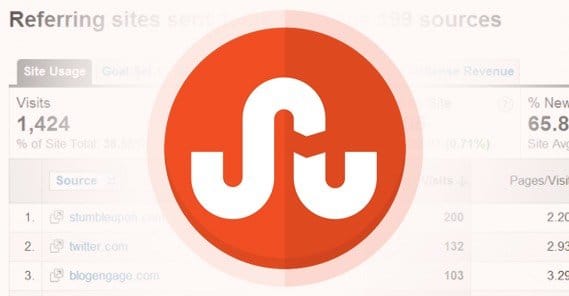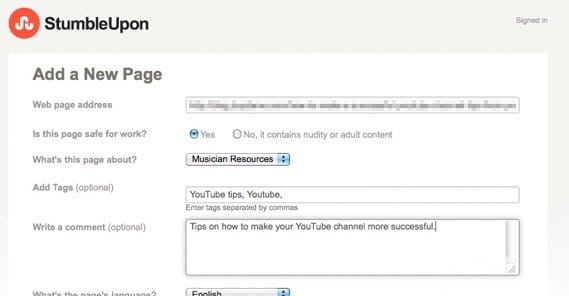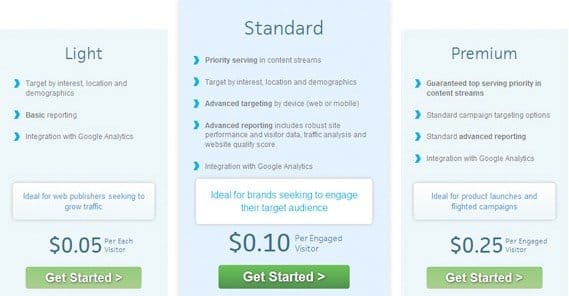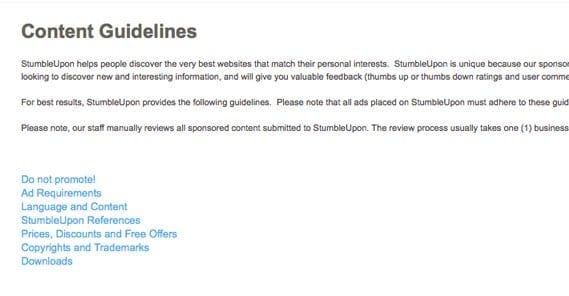How to Use StumbleUpon to Consistently Drive Traffic

StumbleUpon started life as a viral sensation and grew explosively over the first couple years of its existence. Since then, it has been on a bit of a decline, primarily due to the fickle nature of Internet fads. Still, it has a community, it has power-users, it has paid advertising, and it’s still viable for some amount of traffic.
Now, Stumble is never going to supplant your other social networks. It’s nowhere near as good as Facebook, Twitter, YouTube, or any of the other major networks. Consider it a supplement, not a replacement, and you’ll probably enjoy some decent success. Thankfully, you don’t need to put a lot of time into StumbleUpon to see returns.
How StumbleUpon Works
Before I get in to how to use it, let’s first discuss what Stumble is and how it works. If you haven’t used it in a while, this is worth a read, because it has changed somewhat since the early days.
Stumble is essentially a semi-random content discovery network. You, as a user, register for the service for free. You then have the option to browse via a web app, or through a toolbar added to your browser. Both have essentially the same functionality.
Before you can start using the service, you need to add interests. StumbleUpon has a huge list of interests, and every site added to its database is categorized according to those interests. Some of them are small, niche interests with only a small number of followers. For example, the “African Americans” interest has only 15K followers, and the Divorce interest has only 8,000. Meanwhile some other, more broad interests have much more. Ancient History has 438K followers, and Humor has over a million.
As you can guess already, one of the keys to success as a marketer on the platform is picking the right interests. Unfortunately, there’s not a lot you can do about this. More on that later.
When you have a selection of interests ready to go, you can click the Stumble button. This button chooses a random interest from your list, and chooses a random site within that interest from within their database of submitted sites.
Once on a page you visited through Stumble, you have a few options. You can click to upvote or downvote it. This refines the algorithms that choose which pages to show you. Downvote a page and Stumble will show you less content along those lines. Upvote one and it will attempt to show you more similar pages.
You can also click to add a page to a list, or click to share it with your Facebook or Twitter timelines.
Stumble is also a social network, which means you can see and interact with other users. You can view lists they’ve created, follow their submissions, and even stumble through their liked pages. This is really all tertiary to the central focus of the site, though, and won’t be a huge part of using it properly.
When you visit a page that isn’t in the StumbleUpon database – like a freshly posted blog post on your site – you can add it to the database. This is easiest done if you have the browser toolbar installed. All you need to do is upvote it, and you’ll be asked to submit some basic information about it. Alternatively, you can visit the submit page URL and add information. Stumble asks you the URL, whether or not the page is safe for work, what interest category it should fall under, any tags it should have, a comment you want to leave, and the language of the page.
As you might imagine, filling out this information properly has a big effect on how successful you will be using the platform.
How Paid Stumbles Work
As I mentioned before, StumbleUpon has a paid discovery option. It’s not very robust, though they like to present it as if it is. Just look at their page for it.
Essentially, a paid stumble is just you paying to make sure your site comes up more often in the “random” stumbles of other users. You pay to target users who have certain interest profiles – you actually get quite a lot of data to comb through, though it’s not quite as robust as Facebook’s system – and you get traffic from users browsing through Stumble.
One benefit to StumbleUpon’s paid ads system is the fees. You don’t have to worry about optimizing your costs to get the most traffic for your buck, because it’s a fixed, flat fee. You pay five cents for each paid stumble delivered through Stumble Ads.
By contrast, you have something akin to Google’s Quality Scores, called the Feedback Score. This feedback score is Stumble’s way of interpreting how users react to your pages; do they stick around, do they upvote or downvote you, do they share your page, and so forth. Better metrics mean better sway in the community. If your feedback score is high enough, you’ll end up in the Popular tab, and will be able to get a lot more organic traffic.
So, you don’t have to worry about audience optimizations to lower costs, and you don’t have to worry about creating Stumble-specific ads. All you have to worry about is accurate information and keeping your feedback scores up.
Stumble Ads Content Guidelines
In order to use StumbleUpon’s ads system, you need to comply with their guidelines. That said, you don’t necessarily need to comply with them to use organic stumbles as a source of traffic. The biggest example of this is adult content. There are adult-centric interests and straight-up pornography as interest categories, but adult content of every type is blocked from ads via the content guidelines.
You cannot promote:
- Adult content, including nudity, sexual imagery, excessively suggestive content, sexual dating sites, adult toys and adult products.
- Offensive, profane, vulgar and obscene content.
- Content focused on illegal drugs, tobacco products, e-cigs, guns, ammunition, and other weapons.
- Content focused on gambling, bingo, or poker.
- Scams of any sort.
- Contests of any sort.
- Money making opportunities, particularly those skirting the line of scam.
- Non-accredited colleges or web colleges.
- Online pharmacies.
- Hateful or terrorist agendas.
- Spam.
As for your “ads” themselves, they’re just pages on your site. They can’t be redirected URLs, they can’t be copied or stolen content, they can’t be referral pages, affiliate URLs or squeeze pages. They can’t have pop-ups or pop-unders. They can’t have autoplay audio, and they can’t have exit-capture scripts that prevent an exit. Exit intent scripts, however, are fine.
There are other guidelines, as well, giving you details about language, formatting, and other rules. For the most part, you’ll be complying with all of this if you use any other ads system or if you’re paying any attention to SEO.
Why Stumble Gets a Bad Rap
There’s one reason Stumble gets a bit of a bad rap from marketers, and that’s because it has declined in quality and usage over the last several years. The userbase is down, because it isn’t as popular as it once was, and isn’t the viral sensation it was back when Facebook memes were made about using it to procrastinate.
The traffic you get from it is also unlikely to be of great quality. The only way you have control over who sees your page is when you pay for ads, and that does nothing to filter your organic feed. You’re completely at the mercy of whoever decides to browse through the interest you’re using.
Stumble is also used primarily by people who really want to find new content, but don’t want to spend a lot of time looking at it. As such, your engagement, your time on site, and your bounce rate will all be bad compared to the traffic you get from Facebook, Twitter, YouTube, Pinterest, and the other big networks.
That said, if you can gain some traction, you can do well. It’s worth trying, specifically for one reason; it’s a very quick and painless process to use the site.
How to Effectively Use StumbleUpon
So, after all that, if you’ve decided you’d like to use StumbleUpon – and really, as negative as I might make it sound sometimes, it’s worth trying – here are tips you can use to succeed.
Fill out your profile properly and completely. Primarily, this means including a picture to go along with your profile. Filling out a name instead of an alias, and your location information, is really optional as long as your username is fine. You have space for a description, but you don’t want to make it marketing-focused, otherwise people will shy away from your profile. Instead, make it more of a personal profile description. Really, out of all of it, the picture is what lends you the most legitimacy.
Add content properly. Remember how I went over everything you can put in on the URL submit page? Make sure to fill that all out. Tags aren’t hugely important, but the comment can be very helpful, particularly if you’re not making it a second meta description. Use it as an actual comment. The biggest part of proper URL submission, though, is picking the right interest category. Browse the list of interests and look for high-capacity interests that fit your site. Remember; one of the fastest ways to tank your visibility is to miscategorize your site and show up for people who aren’t interested in what you’re showing.
Add your own content, but add other content as well. If your account is dedicated to submitting pages on your own site, you’re going to find yourself filtered as a spam account very quickly. The best way to get around this is to share and submit content other than your own on a regular basis. Try to work in at least two upvotes and one new URL submission for a site other than your own for every page of your own you submit. This isn’t a hard and fast rule, of course; play it by feel, and if you feel like you’re submitting too many of your own pages too quickly, dial back for a few days.
Use Stumble as a normal user; curate content in addition to adding your own content. The more you look like a business on the site, the less you’re going to be shared or followed. Obviously, your blog posts are business-focused, but you need to avoid being too promotional in your descriptions, comments, and submissions.
Be patient. Stumble can take quite a while to process new sites, and it can take even longer for users to start sharing your sites. There are millions of pages in the database, which means it takes a long time for your pages to come up. Once they do come up, though, a few upvotes can send your pages skyrocketing in popularity, at least for a short time.
Have sufficient volume. StumbleUpon is very much a game of numbers. Every individual page you submit has to compete against all of the others in that interest category, and often in other interests as well, just based on how people browse multiple interests at a time. The more pages you have in the database, the more chances you have to be seen, upvoted, and explored.
Make sure your content has immediate value to hook users. We’re talking Buzzfeed or Upworthy here; something immediately interesting to grab the user’s attention and force them to stick with the page. The average StumbleUpon visit length is around a quarter of a second; think of it like channel surfing on TV when there’s nothing to watch. You need to be that split second of interesting content that settles the channel for an hour.
Encourage users to upvote your pages as much as possible. As mentioned, upvotes are what causes your page to show up more often for more people. The more upvotes you can get, the more popularity your pages will receive. Do everything you can to get upvotes short of paying for them. I don’t recommend going all-in with graphical banners pointing at the upvote button, but that’s only because it’s wasted screen space you could dedicate to more valuable social networks, like Facebook or Twitter.
Don’t be afraid to use the social aspects of the site. That means following and friending other users, in hopes that they friend you back and explore your interests. Any user will notice when someone follows them, and most of them will check out who it was and see what they’re into. Ideally, though, you’ll follow people who upvote your content, as well as people who have interest profiles similar to your own. StumbleUpon gives a nice little analysis of the interests a user likes, and the categories they prefer, so try to match those as much as possible.
Use Stumble among your social sharing buttons, to remind users that they can vote up your page if they use the site. Stumble themselves have a number of different buttons you can use, but you’re not limited to their templates. Virtually every major social sharing plugin, for WordPress and for other blog platforms, will have some set of icons for StumbleUpon. Pick one you like and use it in your tray along with all the rest.
Consider forming a group of webmasters to help promote each others’ content. If you were doing this for ad clicks or for links, it would be against Google’s policies and you could be flagged for black hat manipulation. However, since Google doesn’t pay attention to social signals from StumbleUpon, and since Stumble doesn’t prevent it, you can just form a group of mutually assistive users. Be careful about how you promote it, though, just in case.
Create curated lists that include your content and the content of other users. Don’t create a list that’s all your content; if users want to see your content, they can browse your site. What you want to do is attract users to small curated lists of content, and get them to vote up everything in it, including your content.
Finally, you can use paid stumbles if you want, but it’s not entirely necessary. The beauty of it is it can help jumpstart your first few posts, to get your account in good standing and get you the first bit of popularity. I highly recommend writing a few very viral-themed posts, or pushing your most popular recent posts. You never want to pay to promote articles that will be ignored or downvoted.
Overall, StumbleUpon can be good for a lot of cheap or free organic traffic, but that traffic won’t be quite as good as what you get from other social networks. Use it as a supplement, don’t try to center your marketing around it.
 ContentPowered.com
ContentPowered.com









